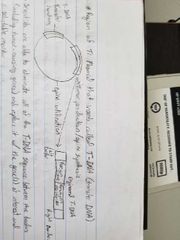![]()
![]()
![]()
Use LEFT and RIGHT arrow keys to navigate between flashcards;
Use UP and DOWN arrow keys to flip the card;
H to show hint;
A reads text to speech;
23 Cards in this Set
- Front
- Back
|
What is genetic engineering? |
The use of recombinant DNA technology to alter an organism's genotype and phenotype. It's application is called biotechnology. |
|
|
What is an inducible expression vector? |
A bioengineered construct (often a plasmid or virus) designed to introduce a target gene in a cell. They are designed so you can control when the introduced gene is expressed. |
|
|
What phase of cell growth is the best time to express an inducible expression vector? Why? |
The log phase (after the lag phase and before the plateau). Because it is the best time for protein synthesis. |
|
|
What is a transgene? |
A gene that had been modified by externally applied recombinant DNA techniques and introduced into a genome. |
|
|
What is a transgenic organism? |
One with a genome modified by a transgene. |
|
|
What do inducible expression vectors need to work? |
A strong promoter with an operator. A repressor gene and an inducer gene. |
|
|
What are organisms that have received DNA from another species (a transgene)? |
Genetically modified organisms. Also called transgenic organisms. |
|
|
What are some ways that transgenic organisms are used? |
For human benefit (eg: to develop drugs) To study the function of a gene when it is over-expressed in vivo |
|
|
What is gene addition? |
Adding a transgene through nonhomologous recombination. The gene randomly inserts into the host genome (called ectopic insertion). |
|
|
What is gene replacement/knock out? |
Inserting a transgene by homologous recombination. The cloned gene replaces the original gene. |
|
|
What is a Ti plasmid? |
A cloning vector of Agrobacterium tumifaciens that enables bacteria to infect plant cells and produce a tumor (crown gall disease). |
|
|
What is T-DNA? |
Transfer DNA. It is the region of a Ti plasmid that inserts into plant cells targeted to be genetically modified. Originally contained tumor inducing genes, but now scientists can eliminate these genes and replace them with genes of interest and a selectable marker. |
|
|
How do you create a genetically modified plant using Ti plasmids? |
1. Infect cut segments of plant tissue with bacteria containing Ti plasmid so T-DNA can integrate into host plant chromosome. 2. Place on a medium containing a selectable marker (ex: kanamycin) 3. Successfully transformed plant cells can be cultured and grown into plants. 4. Transformed plants will follow a Mendelian pattern of inheritance. |
|
|
What is Bt toxin? |
Contained in genetically modified plants to target crop pests and kill them. Not harmful to pollinators or humans. |
|
|
Describe a Ti plasmid. |

|
|
|
What is the procedure to create a transgenic mouse? |
1. Inject several hundred copies of transgene into pronucleus of fertilized egg. Transgene will ectopically/non-homologously insert. 2. Implant embryos into foster mother. 3. If successful, embryos will express transgene in all cells. About 10-30% of offspring will contain foreign DNA in all their tissues and germ line. 4. Interbreed mice until all offspring express transgene.
|
|
|
What are ectopic insertions? |
Nonhomologous insertions of transgenes, usually with multiple copies of the gene at each insertion point. Aka: random insertion |
|
|
What is gene targeting? |
Gene knock out or gene replacement. The transgene is inserted into a location occupied by a homologous sequence in the genome and replaces it's normal homologous counterpart. |
|
|
What are embryonic stem cells? |
Special stem cells that can differentiate to form any cell type in the body, including the germ line. |
|
|
What is the procedure to make knockout mice? |

1. Create a vector. Homologous regions, neomycin resistance gene as selectable marker, thymidine kinase gene. 2. Inject vector into embryonic stem cells of homozygous dominant brown mouse. Three possible outcomes. a. Actual targeted insertion. Gene you want to knock out is replaced with target from vector. Neomycin resistant and thymidine kinase negative. b. Random insertion somewhere in genome. Neo^R and tk+ c. No insertion. Neo^S and tk- 3. Screen for success: Add G418 to kill all neomycin sensitive cells. Add ganciclovir to kill all tk+ cells. Only successful gene knock out cells will survive. 4. Inject ES cells from brown mouse into blastocyst stage embryo from black mouse. (blastocoel = cavity of blastocyst where injection takes place). 5. Implant blastocysts into homozygous recessive black mouse foster mother. 6. Examine mouse pups for coat color. All black means no engraphment. Brown with black stripes means chimeras with successful engraphment. Have knockout but aren't entirely knocked out. 7. Cross chimeras until get all brown mice. Means all cells are successfully knocked out for target gene. Test genotype for homozygous Dominance. |
|
|
Explain mouse embryogenisis. |
Formation: Zygote undergoes cleavages. 16 cell stage = morula. 64 cell stage = blastocyst. Divided so 13 cells provide inner cell mass that eventually turns into the mouse. The other 51 cells are involved in making the placenta. |
|
|
What are endogenous retroviruses? |
Retroviruses that are part of the genome. Don't Express viral particles anymore. Some express envelope genes, which produce proteins called syncytins. These produce syncytiotrophoblast, which leads to creation of placenta. |
|
|
What is molecular farming? |
The production of medically important proteins in agricultural plants/mammary glands of livestock. |

